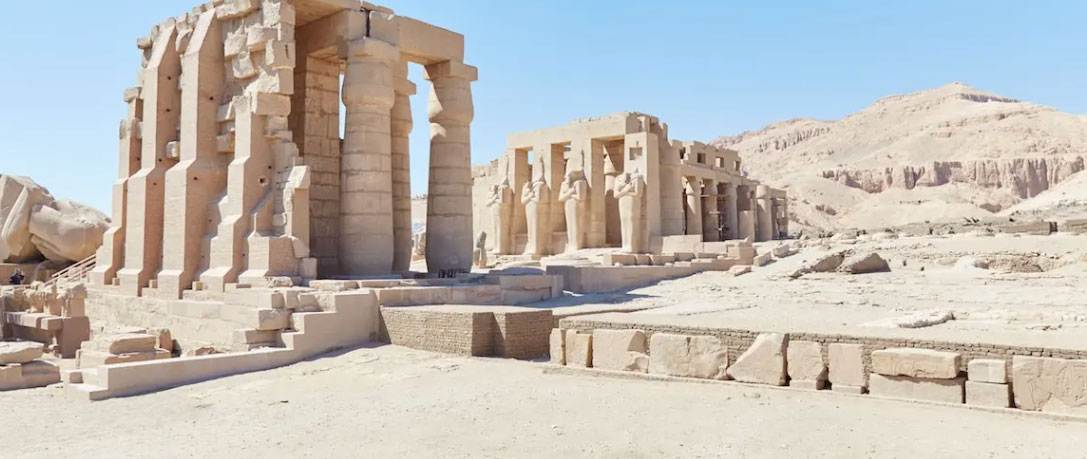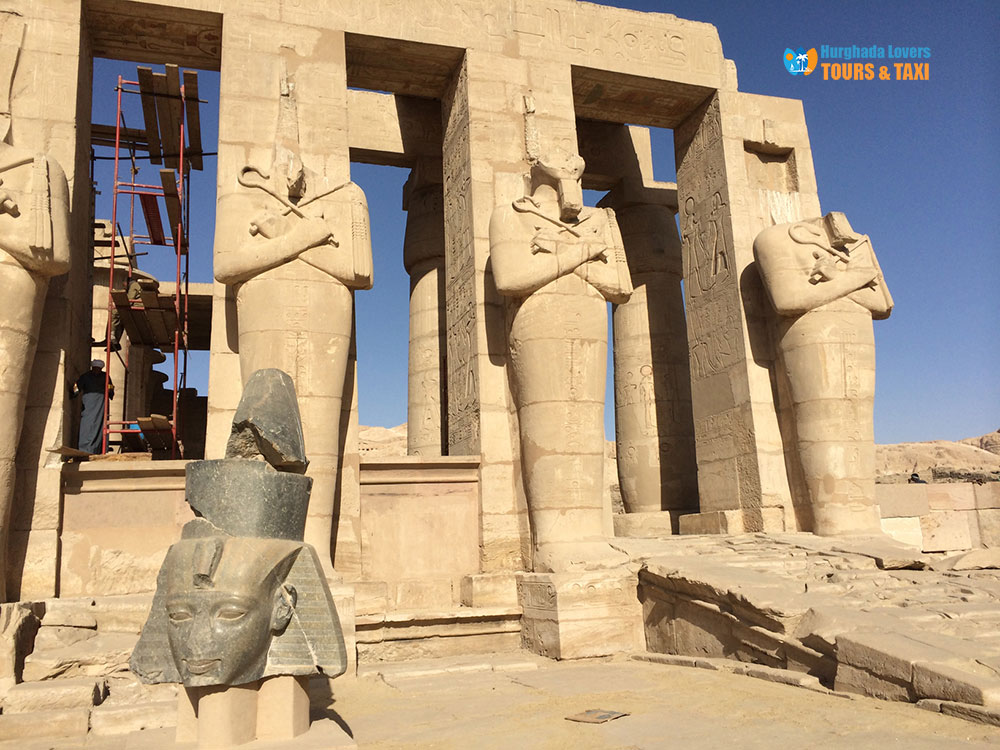Temple of Ramesseum in Luxor Egypt | Egyptian Temples
Facts about the construction of the most famous Pharaonic funerary Mortuary Temples during the reign of King Ramses II of the Nineteenth Dynasty of Egypt in the civilization of Ancient Egypt.
The most important Pharaonic Egyptian Monuments and Egyptian temples of King Ramses II, the most famous Egyptian Pharaohs kings in the era of The New Kingdom of Egypt, and what are the secrets and history of ancient Egypt for building the temple.
Discover he Pharaonic engravings and drawings that were discovered to tell us the culture and history of the Pharaonic civilization “Ancient Egypt History” to start a trip to visit the tourist attractions in Luxor in addition to learning about the tourist attractions in Egypt Archaeological Sites.
Temple of Ramesseum Facts
Temple Type: Funerary Temples
Area: 130,000 square feet.
Construction date: 1292 to 1225 BC.
Length: 180 meters
Width: 66 meters
The temple is surrounded by a large mud brick wall 270 metres long and 175 metres wide.
Who built the temple?
King Ramses II.
What is the reason for building the Ramesseum temple?
The main purpose of building the temple was for King Ramses II to show his strength and the status he had reached throughout history and among the pharaohs, and that he had received the Coronation of the Pharaohs, as he is considered the king who built the most temples..
The Ramesseum temple was dedicated to the worship of the God Amun, the most famous of the ancient Egyptian deities – Ancient Egyptian gods and Goddesses.
Temple names and titles:
Khnemet Waset means united with Waset in Ancient Egyptian Language.
Memnonium in Greek culture
The secret of Maat-Ra or Osi-Ma-God Ra throughout Pharaonic history.
Millions of years palace.
What is the importance of the Ramesseum?
A large number of Ancient Egyptian Papyrus were discovered in the secret storerooms of the Ramesseum Temple, telling us the secrets of Architecture in ancient Egypt Pharaonic Egypt, such as the Sinuhe Story Papyrus from Ancient Egyptian Literature.
You can reach the temple by connecting The Colossi of Memnon located in front of the Mortuary Temple of Amenhotep III (built during the reign of King Amenhotep III) and the western bank of the Nile River with ease, but unfortunately most of the temples were destroyed as a result of erosion and climate conditions over the ages..
The Ramesseum temple was called by many names in Greek civilization, such as “Memnonium” and the tomb of Ozymandias, as the name goes back to the Ethiopian fictional hero Memnon, son of Tithonus and Eos, with the huge statue located in the temple..
The temple was named the Tomb of Ozymandias, due to the distortion of the word Usermaat-Ra, which means the coronation of the king. Pharaonic inscriptions were discovered to indicate the development of Sculpture in Ancient Egypt, and phrases on the statue of Memnon in the temple: “I am Ozymandias, King of Kings. If anyone wants to know how great I am, and where I lie, let him prove me in one of my works.”:.
The mortuary temple measures 600 by 220 feet, with the Ramesseum having an area of over 130,000 square feet..

Map of the Ramesseum Temple from the inside:
When you start your journey to see this unique archaeological site, you will find a large monument on the eastern side at the entrance to the first courtyard of the funerary temple, then drawings and engravings that are considered to be about the Syrian military campaign carried out by King Ramses II “as he was interested in developing the army Military of ancient Egypt” in 1288 BC..
The battle was drawn for the king fighting the Hittites army himself and defeating them in the Battle of Kadesh on the Orontes River in the fifth year of the king’s rule of Egypt, as it is considered one of the most famous war and military battles in the ancient Egyptian civilization of the pharaohs found in the temples of Luxor on the West Bank.
You will find drawings on the sea tower of the names of 18 cities occupied by King Ramses II, in addition to engravings of prisoners of war and other drawings until you reach the southern tower..
You will find that the first courtyard in the Ramesseum Temple was destroyed by 90% due to the climate and erosion conditions, and you will find on the western side of the courtyard a group of Pharaonic statues that remain until now, but they are remains..
When you go to the second courtyard in the funerary temple, you find two rows of round columns, and on the eastern side, a row of square columns on which are located Osirian statues, and on the western side, a row of Osirian columns in the shape of a square facing the courtyard directly, located on a high balcony, then a row of columns with capitals in the shape of papyrus buds..
Over time, there were no more Osirian statues left, and there were only 4 statues in each row of Ramses II, as one of the famous archaeologists and Egyptology, Diodorus, described them as “supported instead of square columns by animals, each carved from a single piece of stone, 16 cubits high, and carved in the ancient manner.”.
When you head to the western side of the Ramesseum Temple, you will find Pharaonic drawings and scenes of King Ramses II kneeling before the Thebes Triad, and on the left side King Ramses II leads the God Montu, the god of war, and the God Atum, the king forward, then drawings of the children of King Ramses II, and then at the top engravings of the king offering sacrifices to the God Min God Ptah and another god, as was believed in ancient times by the Pharaohs..
Hypostyle Hall of the Mortuary Temple:
It contains 3 huge doors at the end of the three steps and is of the same architectural design as the hypostyle hall in the Karnak Temple complex..
You will find engravings on the western side of King Ramses II attacking a city in Galilee while riding his chariot with horses, victorious over the enemies.
On the other side you will find engravings of King Ramses II receiving the sign of life from Amun next to God Khonsu and God Sekhmet, in addition to one of the most important temples of Luxor on the West Bank, engravings of the children of King Ramses II..

Hypostyle Hall of the Ramesseum:
When you go to the small hall of columns with a ceiling standing on 8 columns with capitals of pharaonic papyrus buds, in addition to drawings and engravings of the king with the gods.
On the eastern side, there are carvings of the procession of the sacred boats of the Theban Triad, then on the western wall, there are carvings of King Ramses II (who has the Temple Ramses II in Sohag, the Tomb of King Ramesses II | KV7 in the Valley of the Kings, in addition to the Temple of Abu Simbel in Aswan) sitting under the branches of the Tree of Life with the God Thoth and the God Seshat, who are writing the king’s name on the leaves of the tree, believing that this will immortalize his name..
You will find a hall behind the small hall, but it is 100% destroyed. You will find 4 columns with Pharaonic drawings and engravings on them, in addition to old buildings and mud brick warehouses from the era of the Pharaonic King Ramses II..
You will find the temple of Prince Wasemose, son of King Thutmose I of the 18th Dynasty “Eighteenth Dynasty of Egypt“, south of the Ramesseum Temple.
Egyptologists and archaeologists found paintings and statues in the temple and transferred them to the Luxor Museum and The Egyptian Museum in Tahrir Square (Museums in Cairo), in addition to the remains of Pharaonic buildings south of the temple of King Thutmose IV, father of King Amenhotep III, located in the Luxor Temple on the West Bank..
As you head south you will find the temple of Queen Twosret, wife of King Seti II of the 19th Dynasty, but the temple is largely destroyed in a small area of Nile silt and gravel. Archaeologists explain that Queen Twosret ruled in ancient Egypt “Ancient Egyptian Government” after the death of king Merneptah.
When you leave the Temple of Queen Tawosret and head south, you will find the Funerary temple of Merenptah, son of Ramses II.
Unfortunately, over time, a large part of the temple was demolished, as it was two-thirds the size of the Ramesseum..
In the Ramesseum you will find a large courtyard, then a courtyard containing Osirian columns, then two halls, one containing 12 columns and the other 8 columns, then many rooms behind the two halls..
In 1896, the famous archaeologist Flinders Petrie found a granite plaque “Ancient Egyptian Metallurgy” bearing the name of King Merneptah and inscribed with words referring to the victory of King Amenhotep III..

About King Ramses II:
Reign: 1279-1213 BC
Date of Birth: 1300 BC
Date of death: 1213 BC
Pharaonic Dynasty: The Nineteenth Dynasty
Wives:
Queen Nefertari and Queen Meritamen are the most famous queens of Pharaonic Egypt “Female Pharaohs“.
King’s titles:
Nefertari’s wife(s)
Neferu Ra died
Children
Amun Hor Khepeshef
Prince Ramses
Khaemwas
Merneptah
Mary Atom
My daughter
Mert Amon
Father: King Seti I
Mother: Queen Tuya
Burial place: Tomb 7 in the Valley of the Kings, Luxor
Works of King Ramses II:
Conducting military campaigns to the lands of Shalam up to Canaan and protecting the borders of southern Egypt as in the Geography of ancient Egypt up to the lands of Nubia.
Building the city of Pi-Ramesses in the Delta region on the Nile River.
Construction of the Ramesseum and buildings at Karnak Temple.
His era witnessed prosperity and stability in Agriculture in Ancient Egypt, Industry in ancient Egypt, Ancient Egyptian science, and mummification among the ancient Egyptians “Mummification in ancient Egypt“.
Ramesseum Temple Address:
Desert Back, Luxor, Egypt
Ramesseum Temple Visiting Hours:
Daily from 09:00 AM to 05:00 PM
Ramesseum Temple Entrance Ticket Prices:
Note: Facts and secrets of the history will be added soon…
Hurghada Excursions Lovers, Best Travel Agency in Hurghada to provide daily tours to visit the Tourist attractions of Luxor by Hurghada to Luxor Tours and Hurghada to Pyramids Trips. Book online when you come to Hurghada, El Gouna, Sahl Hashish, Makadi Bay, Soma Bay, Egypt Tours Packages.
